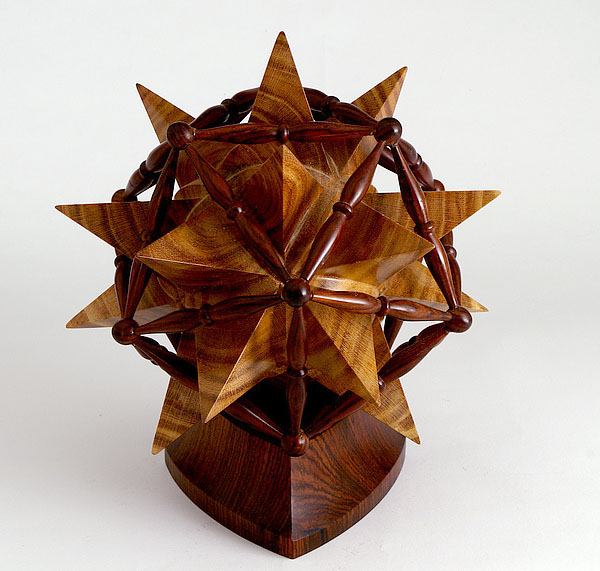Bob Rollings |
"Totally Turned"
Wood, 6 x 6 x 8 inches, 2007.

This sculpture has been totally turned on
the lathe. As far as the central icosahedron is concerned, this is
possible by turning on 12 centres as five faces lie on the same plane.
Therefore the 60 (5 x 12) faces of the 20 three sides stellations. The
inspiration for my interpretation came from Perspectiva Corporundum
Regularum by Wenzel Jamnitzer (1568). The wood for the core icosahedron
is honey locust; the web and base are made from cocobola.
"A Stick or Tunbridgeware Dodecahedron"
Multiple Wood Varieties, 7 x 7 x 7 inches, 2007.

This Dodecahedron was the result of
having made ten sided sticks to produce spinning tops. Having a piece
left over, I decided to make this shape. I converted the stick into a
pentagon by cladding the sides with oak. I then cut 12 panels about
3/16 inches thick and jointed them together to produce the dodecahedron.
Tunbridgeware, as this type of ornamentation came to be known as,
reached its height of intricacy in Tunbridge Wells in Kent England in
the 19th century. The various woods used in this piece are holly,
cocobola, pear, white oak, maple and black dyed veneer.
"Metamorphosis"
Wood (Ebony and Boxwood),12 x 12 x 16 inches, 2008.

The relationship between the
dodecahedron and icosahedron is shown here in a piece called
Metamorphosis. It began with a central dodecahedron. In the centre of
each of the twelve faces, spindles were projected to create the 12
vertices of the icosahedron. Finally the icosahedron was stellated to
create the 20 vertices of the dodecahedron. The web was then connected
between these vertices completing the process of metamorphosis. The
relationship of the base to the sides of the pyramids built upon the
icosahedron is in the ratio of 1 to 1:1.618 – a divine proportion.
"Tetrahedron with a Twist"
Wood, 6 x 6 x 6 inches, 2008.

This tetrahedron was made from a six
inch walnut sphere. After locating the position of the four vertices,
it was hollowed out leaving a ¾ inch wall thickness. This left enough
wood to create the six dual spirals which connect the four vertices.
The spirals themselves were formed using a Dremel burr, sandpaper and
lots of patience.
Bob Rollings, Freelance artist
Toronto, Ontario
"My interest in geometry stems from a
lifetime spent in the cabinet making industry. Initially I worked as a
hands-on craftsman and then later in a supervisory position which
comprised of interpreting designer/architectural concepts and turning
them into practical and beautiful pieces. After my retirement, I turned
my interest in geometry into a hobby, using wood as a medium. My
investigation and interpretation of the platonic solids has been
influenced by Johannes Kepler, Luca Pacioli, Leonardo De Vinci, M. C.
Escher, and later by Buckminster Fuller and Donald Coxeter. After
exhibiting some of my work at the Fields Institute, I was invited to
share space in Donald Coxeter’s showcase in the Department of Math at
the University of Toronto. Using a lathe as my primary tool gives me a
more individualistic approach to the study and presentation of
polyhedra."
in care of david.cameron.26@gmail.com |